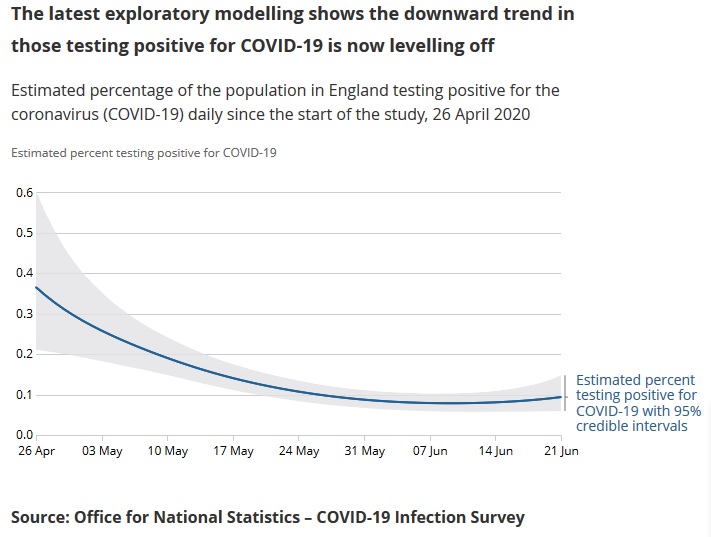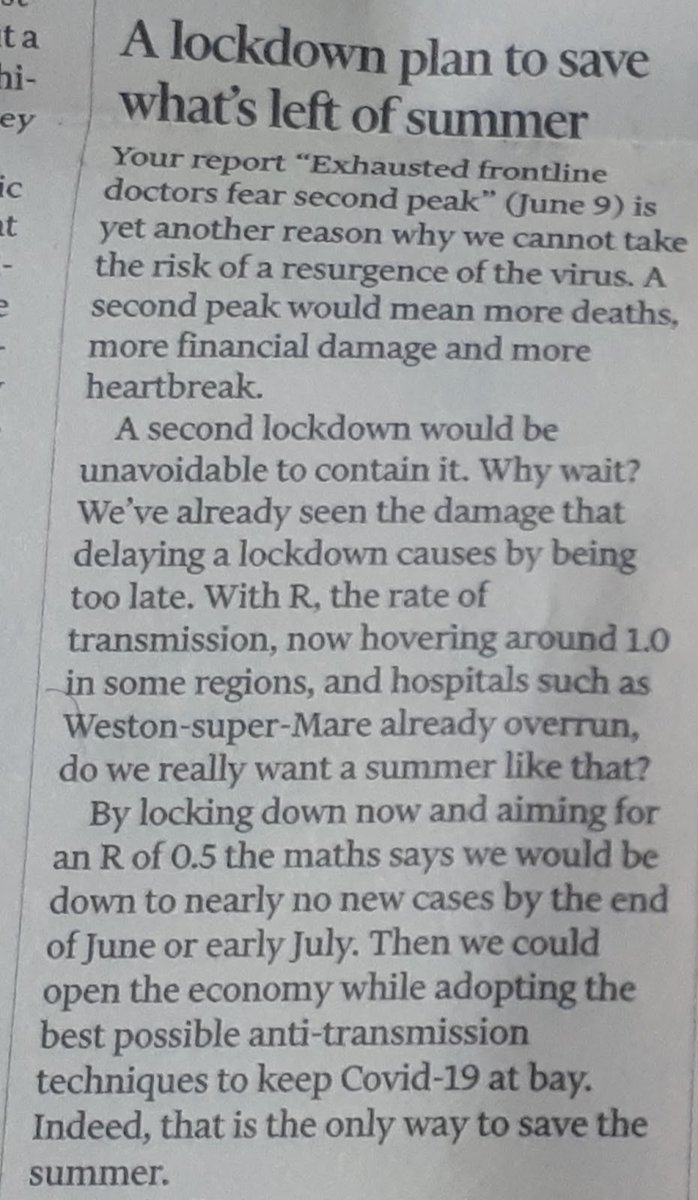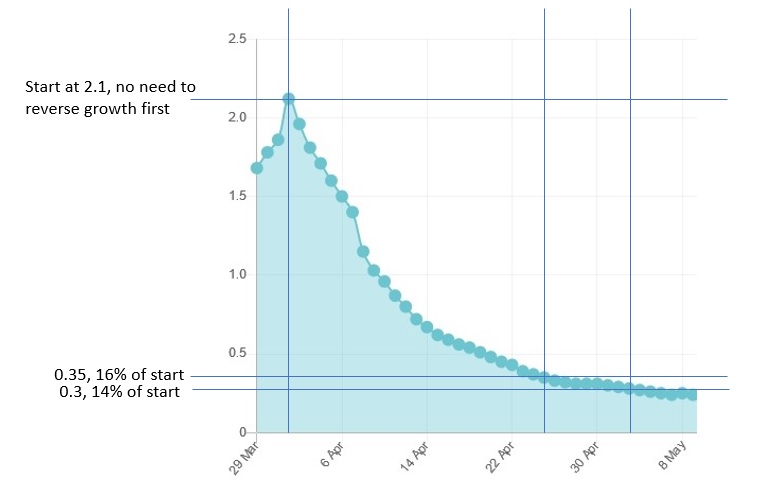UPDATE ON COVID-19 INFECTIONS FROM THE ONS
On Tuesday 23 June PM Johnson announced that COVID-19 infections in England had dropped to 1 in 1700, and that various easings could take place as planned on 4 July.
1 in 1700 is equivalent to 0.06% of the population in England.
1/n
On Tuesday 23 June PM Johnson announced that COVID-19 infections in England had dropped to 1 in 1700, and that various easings could take place as planned on 4 July.
1 in 1700 is equivalent to 0.06% of the population in England.
1/n
With 0.06% in mind, Matt Hancock announced at the press briefing last Thursday 18 June that the “…ONS’s (Office for National Statistics) survey... implies around 4.5 thousand new cases per day”
https://www.gov.uk/government/speeches/health-and-social-care-secretarys-statement-on-coronavirus-covid-19-18-june-2020
2/n">https://www.gov.uk/governmen...
https://www.gov.uk/government/speeches/health-and-social-care-secretarys-statement-on-coronavirus-covid-19-18-june-2020
2/n">https://www.gov.uk/governmen...
Today Thursday 25 June the ONS has announced that “The decrease in the number of people in England testing positive for …COVID-19 has levelled off.”
However the graph accompanying the statement shows infections have steadily risen from 0.06% to 0.1% in the last fortnight
3/n
However the graph accompanying the statement shows infections have steadily risen from 0.06% to 0.1% in the last fortnight
3/n
That implies:
•R has been over 1.0 for more than 2 weeks, not in the range 0.7-0.9
•Around 6,900 people per day are being infected in England
Here& #39;s the announcement:
#infectionstudy">https://www.ons.gov.uk/peoplepopulationandcommunity/healthandsocialcare/conditionsanddiseases/articles/coronaviruscovid19roundup/2020-03-26 #infectionstudy
4/n">https://www.ons.gov.uk/peoplepop...
•R has been over 1.0 for more than 2 weeks, not in the range 0.7-0.9
•Around 6,900 people per day are being infected in England
Here& #39;s the announcement:
#infectionstudy">https://www.ons.gov.uk/peoplepopulationandcommunity/healthandsocialcare/conditionsanddiseases/articles/coronaviruscovid19roundup/2020-03-26 #infectionstudy
4/n">https://www.ons.gov.uk/peoplepop...
The ONS survey also says “Our latest estimates for 8 to 21 June 2020, suggest an average of 51,000 people in England had COVID-19, an increase from an average of 28,000 in the previous period, 25 May to 7 June 2020.”
These are averages. 0.06% is c33,000, 0.1% is c55,500.
5/n
These are averages. 0.06% is c33,000, 0.1% is c55,500.
5/n
6,900 a day from the ONS is significantly higher than the 1000-1200 figures being mentioned on the BBC and other media. These reflect the 7-day rolling average to 23 June derived from official testing of 1,147.
6,900 is also substantially higher than the 653 on 24 June.
6/n
6,900 is also substantially higher than the 653 on 24 June.
6/n
This is for several reasons, including:
• Not everybody with symptoms gets tested
• Not everybody sent a test returns it
• False negatives are up to 40%, due primarily to poor swabbing
The ONS survey is more representative, although the confidence interval is a concern.
7/n
• Not everybody with symptoms gets tested
• Not everybody sent a test returns it
• False negatives are up to 40%, due primarily to poor swabbing
The ONS survey is more representative, although the confidence interval is a concern.
7/n
With R already over 1.0, we’ve already got a second wave. It would be inadvisable to go ahead with the easings on 4 July, which would only stoke the flames.
Indeed the government needs to seriously consider a second lockdown to nip the wave in the bud.
8/n
Indeed the government needs to seriously consider a second lockdown to nip the wave in the bud.
8/n
After all, PM Johnson did say on Tuesday, as he has said before, that easings would be reversed if necessary.
That can’t be an empty promise. It is in everyone& #39;s interest to avoid a catastrophe.
9/n
That can’t be an empty promise. It is in everyone& #39;s interest to avoid a catastrophe.
9/n
Professor Whitty, Chief Medical Officer for England, said back before the first easings on 11 May, that daily infections should be below 1,000 before easings are made.
https://www.dailymail.co.uk/news/article-8276173/Ministers-warn-lockdown-stay-MONTHS-new-cases-drop-hundreds.html
10/n">https://www.dailymail.co.uk/news/arti...
https://www.dailymail.co.uk/news/article-8276173/Ministers-warn-lockdown-stay-MONTHS-new-cases-drop-hundreds.html
10/n">https://www.dailymail.co.uk/news/arti...
Spain, France and Germany are all half of that threshold, with similar populations.
They are only easing lockdown carefully with significant anti-transmission measures such as wider use of face coverings.
It is nonsense for UK to be considering such easings yet.
11/n
They are only easing lockdown carefully with significant anti-transmission measures such as wider use of face coverings.
It is nonsense for UK to be considering such easings yet.
11/n
The first lockdown reduced daily cases by 86% in just three weeks. That is consistent with an R of 0.4-0.5. So that is what is needed
Use that time to develop a stronger set of anti-transmission measures, and lockdown could be substantially released then, far more safely
12/n
Use that time to develop a stronger set of anti-transmission measures, and lockdown could be substantially released then, far more safely
12/n
So those two recommendations were what were published in the Financial Times on 11 June.
We’ve lost 2 weeks, but not too late to save the summer
Implemented in England by next Monday 29 June, we could be re-opening by 17 July, only two weeks after the 4 July target.
13/n
We’ve lost 2 weeks, but not too late to save the summer
Implemented in England by next Monday 29 June, we could be re-opening by 17 July, only two weeks after the 4 July target.
13/n
A key aspect of easing lockdown is public confidence.
Many parents have not been confident enough to send their kids back to school, when they were encouraged to do so. People say they won’t get on planes, or even visit the shops. Loos and cafes need to be open.
14/n
Many parents have not been confident enough to send their kids back to school, when they were encouraged to do so. People say they won’t get on planes, or even visit the shops. Loos and cafes need to be open.
14/n
Get infections down by 86% and people will be far more confident. Happier to go to the shops. More confident about their jobs. Happier to spend. Meaning a stronger economic recovery
Better for the economy. Better for the Treasury.
A second lockdown is good for us.
15/n
Better for the economy. Better for the Treasury.
A second lockdown is good for us.
15/n
We should also be mindful that a lower rate of infection means far fewer deaths. With widespread reports of major health problems for those people who survive, these would be a far lower too.
Saving the summer. Saving the economy. Saving lives and livelihoods.
16/n
Saving the summer. Saving the economy. Saving lives and livelihoods.
16/n
With infections now on the rise, a short sharp second lockdown is imperative.
Isn’t it?
17/n
Isn’t it?
17/n
You& #39;ll have noticed that the ONS graph has a wide 95% confidence interval compared to the numbers involved. The sample size needs to be increased for such an important study, and hopefully ONS will do so.
But we can only work with what we& #39;ve got...
18/n
But we can only work with what we& #39;ve got...
18/n
So let& #39;s look at the ONS graph again:
(a) The bottom of the 95% interval is flat. So the best case is an R of 1.0 with 0.06% of population
(b) All points above are an R over 1.0
Difficult to tell, but looking like no more than 10% chance that R isn& #39;t over 1.0
19/n
(a) The bottom of the 95% interval is flat. So the best case is an R of 1.0 with 0.06% of population
(b) All points above are an R over 1.0
Difficult to tell, but looking like no more than 10% chance that R isn& #39;t over 1.0
19/n
If there is no more than 10% chance that R isn& #39;t over 1.0, then there& #39;s at least a 90% chance R is over 1.0.
ONS should have said it is likely that R and infections are rising, not that they have "levelled off".
20/n
ONS should have said it is likely that R and infections are rising, not that they have "levelled off".
20/n
I have also now had chance to review the latest results from the King’s College London “COVID Symptoms Study” using the ZOE app. Nearly 4 million participants:
https://twitter.com/COVID__Out/status/1276381027628449793
21/n">https://twitter.com/COVID__Ou...
https://twitter.com/COVID__Out/status/1276381027628449793
21/n">https://twitter.com/COVID__Ou...
In summary, the ZOE study is estimating across the UK:
- New cases are rising and falling around an R of 1.0
- 2,341 new symptomatic cases per day of COVID-19
- Some 130,284 people are currently symptomatic
- Regional Rs are in the range 0.8-1.2. Not good news
22/n
- New cases are rising and falling around an R of 1.0
- 2,341 new symptomatic cases per day of COVID-19
- Some 130,284 people are currently symptomatic
- Regional Rs are in the range 0.8-1.2. Not good news
22/n
This translates to England as:
- An R of 1.0 on average, ranging from 0.8-1.2 across regions
- Some 2,000 new symptomatic cases per day
- Some 110,000 total symptomatic cases
23/n
- An R of 1.0 on average, ranging from 0.8-1.2 across regions
- Some 2,000 new symptomatic cases per day
- Some 110,000 total symptomatic cases
23/n
So King& #39;s College is agreeing with ONS that R on average across England has recently been 1.0 at least. Not 0.7-0.9 as SAGE have said for the last few weeks.
But 2,000 daily cases from King& #39;s versus some 7,000 from ONS
And 110,000 total cases from King& #39;s versus 55,500
24/n
But 2,000 daily cases from King& #39;s versus some 7,000 from ONS
And 110,000 total cases from King& #39;s versus 55,500
24/n
Firstly R.
R is the transmission number that is what is happening with new cases
SAGE& #39;s number is back-calculated from deaths data, amongst other data. Officially it is 2-3 weeks out of date. Frankly useless.
Here is a more detailed assessment
https://bit.ly/R_awol
25/n">https://bit.ly/R_awol&qu...
R is the transmission number that is what is happening with new cases
SAGE& #39;s number is back-calculated from deaths data, amongst other data. Officially it is 2-3 weeks out of date. Frankly useless.
Here is a more detailed assessment
https://bit.ly/R_awol
25/n">https://bit.ly/R_awol&qu...
Then comparing ONS and King& #39;s College ZOE for England
Both studies have significant shortcomings:
- ONS is a relatively small sample of a few thousand, but it is representaitve across the country for all demographics
- ZOE is only for smart devices, excluding poorer people
26/n
Both studies have significant shortcomings:
- ONS is a relatively small sample of a few thousand, but it is representaitve across the country for all demographics
- ZOE is only for smart devices, excluding poorer people
26/n
Poorer people are more likely to be susceptible to COVID-19, perhaps due to their jobs and housing .
So best to regard ZOE as & #39;best case& #39;, daily cases actually somewhat above 2,000 a day.
It was Matt Hancock who said the ONS 0.06% represented 4,500 a day [cont]
27/n
So best to regard ZOE as & #39;best case& #39;, daily cases actually somewhat above 2,000 a day.
It was Matt Hancock who said the ONS 0.06% represented 4,500 a day [cont]
27/n
For ONS 0.06% is equivalent to some 33,300 people, which is only 7.5 days at 4,500 a day.
In contrast, ZOE explicitly suggests people remain symptomatic for 56 days
7.5 days seems too low, 56 days too high. That disparity can& #39;t be resolved without consulting the teams
28/n
In contrast, ZOE explicitly suggests people remain symptomatic for 56 days
7.5 days seems too low, 56 days too high. That disparity can& #39;t be resolved without consulting the teams
28/n
So what can we conclude?
The latest ONS data suggests daily new infections are now nearly 7,000. ZOE at least 2,000. The real number is somewhere in that range.
We also know R is at least 1.0, where that is the upper limit.
29/n
The latest ONS data suggests daily new infections are now nearly 7,000. ZOE at least 2,000. The real number is somewhere in that range.
We also know R is at least 1.0, where that is the upper limit.
29/n
At least 2,000 per day is twice the threshold set by Prof Whitty for easings
It is also more than 4 times the general level per head in Spain, France and Germany, excluding their localised recent flare-up
Far too high to consider the easings due to become effective 4 July
30/n
It is also more than 4 times the general level per head in Spain, France and Germany, excluding their localised recent flare-up
Far too high to consider the easings due to become effective 4 July
30/n
So what do we do about it?
The obvious thing is get daily infections down to nearer continental levels, when we can confidently make comparable easings. That would make for a stronger economic recovery too.
In three weeks we could get it down by 84% to under 500 a day.
31/n
The obvious thing is get daily infections down to nearer continental levels, when we can confidently make comparable easings. That would make for a stronger economic recovery too.
In three weeks we could get it down by 84% to under 500 a day.
31/n
But how? The first lockdown in March into April achieved it.
Realistically the only way to get daily infections below 500 or 1000 quickly is a second lockdown. Because it is summer, and outdoors is far safer than indoors, it can be a different type of lockdown.
32/n
Realistically the only way to get daily infections below 500 or 1000 quickly is a second lockdown. Because it is summer, and outdoors is far safer than indoors, it can be a different type of lockdown.
32/n
So over to the modellers to determine the best way to achieve an R of 0.4-0.5
Probably closing non-essential retail for three weeks, with the carrot of a stronger recovery in July for those businesses.
Maybe keep 6-person meetings outdoors, and the dual-household bubbles.
33/n
Probably closing non-essential retail for three weeks, with the carrot of a stronger recovery in July for those businesses.
Maybe keep 6-person meetings outdoors, and the dual-household bubbles.
33/n
Maybe even let pub gardens and outdoor cafes open from 4 July, as they are ready to do so. Maybe.
The modellers can advise. Start work now?
34/n
The modellers can advise. Start work now?
34/n
In any case we ought to follow what is in the letter in the FT from 2 weeks ago:
- A short sharp lockdown of 3 weeks, and.
- Development of a stronger set of anti-transmission measures to help keep infections down afterwards
Implemented by next Monday 29th, reopen 17 July
35/n
- A short sharp lockdown of 3 weeks, and.
- Development of a stronger set of anti-transmission measures to help keep infections down afterwards
Implemented by next Monday 29th, reopen 17 July
35/n
17 July is important. It is the date that many state schools are breaking up, only a week after many private schools
People with holidays booked want to get away. And they can if the proposal is implemented.
Overnight accommodation could re-open in the UK on 10 July.
36/n
People with holidays booked want to get away. And they can if the proposal is implemented.
Overnight accommodation could re-open in the UK on 10 July.
36/n
Getting infection rates down to be comparable with Spain, France, Greece and Germany will make it much easier to agree & #39;air bridges& #39; and other & #39;travel corridors& #39; with them and other holiday destinations.
Saving the summer here in the UK and abroad.
37/n
Saving the summer here in the UK and abroad.
37/n
Lower infection rates mean people will be more confident to go out after the lockdown to the shops. A stronger economic recovery.
Indeed, avoiding the second wave that already appears to have started.
Saving the economy
38/n
Indeed, avoiding the second wave that already appears to have started.
Saving the economy
38/n
Let& #39;s not forget that a lower infection rate means fewer deaths and other nasty medical consequences.
Saving lives and saving livelihoods.
Saving the summer. Saving the economy.
39/n
Saving lives and saving livelihoods.
Saving the summer. Saving the economy.
39/n
PM Johnson has repeatedly said he will reverse easings if necessary. He said it on Tuesday when he announced the 4 July easings.
Now& #39;s the time for him to show leadership.
A short sharp second lockdown will be better for everyone!
40/n
Now& #39;s the time for him to show leadership.
A short sharp second lockdown will be better for everyone!
40/n

 Read on Twitter
Read on Twitter






